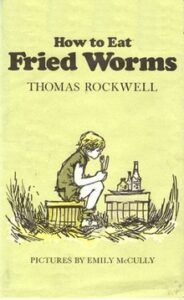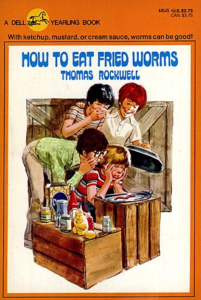
How to Eat Fried Worms by Thomas Rockwell Turns 50 This Year. Does It Hold Up?
How to Eat Fried Worms is celebrating its 50th birthday this year. Would you consider it a classic? I definitely read it as a kid getting into chapter novels. It was right around the same time as Bunnicula and Sideways Stories from Wayside School fell into my eager hands. It was a book that sat alongside my steady diet of Judy Blume and Beverly Cleary. I was curious if Fried Worms would hold up against some of these books that truly have classic status in my mind. So I reread it.
Before I started, I jogged my memory to see what I could recall of the book on my own. To the best of my recollection, the book is indeed about a boy who has to eat worms. For a punishment? For a dare? I couldn’t remember. I did remember that the worms were prepared in a variety of ways. I thought it was funny, and I didn’t remember how it ended. In fact, the worm-eating was done as a bet with $50 at stake. And the ending (spoiler for a 50-year-old book) portrays a kid who now has a taste for worms.
A Challenged Book?!
As I began writing this, I consulted Wikipedia for the names of the characters in the story. Despite having just finished the book days ago, I have already forgotten all the names. Wiki reminded me our worm-eater is named Billy. More importantly, Wiki informed me that How to Eat Fried Worms has been on the American Library Association’s list of most commonly challenged books in the United States. Not only because the book “promotes gambling,” but because eating earthworms is “antisocial behavior.”
I honestly forget that sometimes people get really hung up on the fear of children becoming degenerate gamblers. Luckily for me when I was a middle school math teacher, no one challenged the use of dice or playing cards as tools for learning probability — I legitimately learned how to play craps when I was in middle school! — but plenty of schools forbid such things.
Eating worms, though? Thinking such an act is antisocial behavior is simply xenophobic. People around the world eat worms! Obviously, there are much bigger worms to fry in the battle against book banning, but this is a great example of why these complaints are exhausting.
The Quaint
Back to the book itself. How does it hold up? It certainly has its charms. At heart, it’s a battle of wits between two pairs of boys. Billy the worm-eater has his friend Tom acting as his second, like in a duel. Billy’s rival Alan and his friend Joe scheme to trick Billy into failing to eat 15 worms over the course of 15 days.
Gen-X and elder Millennial readers will probably appreciate the nostalgia the book calls up. These are four extremely unsupervised boys. If your childhood involved lazy summer days spent entirely outdoors with the randos from your neighborhood, the book will send you back there.
Billy plans to spend his winnings on a minibike, which younger readers may have to google. Do they know that in the ‘70s young kids played around with small off-road motorcycles and sometimes lived to tell the tale? They also might be confused why someone’s dad would have a raccoon coat, as is briefly mentioned. But I had a fun sensory flashback to the raccoon coat, some long-lost relative’s relic from the 1920s craze, that lived in the coat closet of my childhood home.
Overall, the basic plot of the book is funny and enjoyable. Billy doesn’t have as much trouble eating worms as Alan thought he would. Alan cooks up some scheme to cheat Billy out of his win. Billy catches on, righteous indignation ensues, and the cycle continues. In the end, they can all ride the minibike Billy buys with his winnings.
The Questionable
While I personally don’t have problems with kids gambling or eating worms, there is a running theme in the book that does get me down a bit: the gender politics. Persistently, the book presents women as people who overreact while the men are the calm voices of reason. The dads are the permissive ones thinking it’s good for boys to engage in this kind of tomfoolery, while the mom is on the phone with the family doctor (also a man) who has to assuage her fears.
It’s a bummer of a stereotype to come across. So was the casual fatphobia, although I’ve certainly read books published this year with worse. Also, the book has a running series of chapter titles comparing Billy’s side to the American forces in World War II and Alan’s side to the Japanese. And that frankly just sat real weird with me.
What About the Movie?

Please believe my love for you, dear reader, because I subjected myself to all 80 unforgivably bad minutes of this movie. The longest 80 minutes of my life! I did not see this movie upon its 2006 release, as that was after I stopped babysitting and before I started being subjected to children’s media again thanks to the children of friends and family.
This movie has absolutely none of the charm of the book, and virtually none of the plot either. If you’d hope a movie could correct the wrongs of its forebear, that hope would be misplaced. Its gender politics seemed worse to me? The movie added a token girl character, who takes on the role of the girl who solves everything for the hapless boy without having a story of her own. That makes me even madder than the hysterical mom for some reason I don’t wish to investigate.
The movie swaps out the battle of wits for scene after scene of gross-out and/or slapstick comedy. And it takes pains to make “ethnic” foods like burritos and Chinese takeout look disgusting, which also did not sit well with my spirit. The only two upsides to the movie: it ends on Junior Senior’s rousing “Move Your Feet,” a great song I hadn’t thought about in many years. And the token girl is played by Hallie Eisenberg (sister to Jesse), which made me look up her Pepsi commercials, which were the closest thing to a viral phenomenon we had in the early ‘90s.
The Final Verdict
If this was one of your favorite books as a kid and you want to share it with a kid of today, you certainly could; it’s not abysmal. It’s also not in league with the aforementioned children’s classics from the mid-to-late 20th century. However, if you’re looking to get a child into reading chapter books, please don’t start with the ones from your own childhood. Go with the kid’s interests! Pick something from the best of what’s being written today! Books that are just fine don’t have to be read by the ages.












